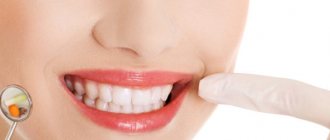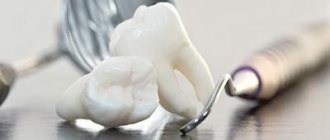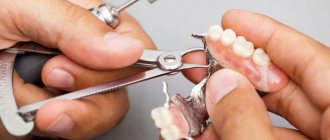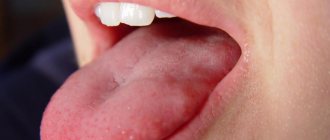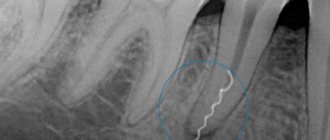Reflex severity
The gag reflex manifests itself in different ways. It is better to choose remedies to help cope with it depending on the severity.
Mild degree
It usually does not cause serious problems during dental treatment. You can deal with it using the following methods:
- When the gag reflex is psychological in nature, the dentist can simply distract the patient. To reduce your stress levels, you can refocus your attention the night before your doctor's visit.
- If the gag reflex is caused by touching the mucous membranes, the doctor protects them with a rubber dam. This is a latex sheet that the dentist uses to cover the mucous membrane. This way it protects it from contact with foreign objects. The rubber dam also allows you to isolate soft tissue from the diseased tooth, providing additional protection.
- Anesthesia. Anesthetic drugs help not only relieve pain in the mouth. They have a freezing effect, the mucous membrane becomes less sensitive.
Average degree
It is very important here to reassure the patient and reduce his anxiety. Regular local anesthesia will not have the desired effect, since it only numbs the pain. Using general anesthesia in such cases is not always justified.
Sedation helps cope well with the problem of fear and nausea. The patient is given nitrous oxide to inhale through a mask. He falls into a relaxed state, but is fully conscious. This is the advantage of sedation over anesthesia, since the contact between the dentist and the patient is completely preserved.
Severe degree
It is not always possible to cope with nausea to such an extent with conventional sedatives. Such cases are an indication for the use of general anesthesia.
Pain and swelling
After tooth extraction, pain and swelling should be expected, the degree of which, however, varies markedly. According to experts, tissue healing after removal usually occurs within 3-7 days. The intensity of pain and degree of swelling may be related to the duration of the operation. As experts explain, to relieve symptoms after tooth extraction, you should temporarily avoid hot, spicy and rough foods, as well as physical activity. If your dentist prescribes you any medications (such as painkillers), you must take them strictly as prescribed by your doctor.
What can a doctor do to reduce the gag reflex?
- Lidocaine. The drug is used for local anesthesia. Lidocaine sprays or gels are usually used.
- Local anesthesia of the palate. This method is used on the upper jaw.
- Conduction anesthesia of the lower jaw. After the administration of the anesthetic, the patient’s cheeks, gums, tongue, and lower lip become numb. Their sensitivity decreases, the doctor is able to carry out therapeutic manipulations normally.
During dental treatment, salivation often increases. Saliva gets onto the root of the tongue, and this increases nausea. To ensure patient comfort, the dentist removes saliva using a saliva ejector. If the reflex is pronounced, you can change the patient’s position and treat him while sitting. This way, less saliva reaches the root of the tongue.
Not only therapeutic procedures, but also diagnostic procedures and impressions before prosthetics or restoration can cause nausea. Here, a lot depends on the methods and equipment used in the clinic.
The 32 Dent clinic uses a new intraoral scanner, Medit 500. It allows you to make a 3D model of your teeth. For the patient, this method offers many advantages compared to traditional impressions:
- Scanning comfort. No powder is needed when using the Medit 500 intraoral scanner. The entire scanning procedure takes place quickly and continuously. The device has a small nozzle, which also reduces the risk that the patient will experience nausea during insertion of a foreign object into the oral cavity.
- High accuracy of results. The Medit 500 intraoral scanner allows you to obtain high-resolution images with minimal error. Thanks to this, the doctor is able to accurately assess the condition of the oral cavity and not carry out additional diagnostic procedures.
- High speed. The image obtained during scanning is immediately displayed on the monitor. In order to obtain a 3D model of the oral cavity, approximately 2 minutes are enough - about a minute for one jaw. Even if the patient has a strong gag reflex, in most cases, attacks of nausea do not occur in such a short period.
- Possibility to interrupt scanning and start it from the desired point. The Medit 500 intraoral scanner is turned on and off with a button. If the patient feels nausea or vomiting. The doctor can take a break and continue the scan from where he left off.
The use of modern intraoral scanners helps our doctors make not only treatment, but also diagnostic procedures comfortable.
What complications may arise after tooth extraction?
Tooth extraction is a surgical intervention to which each body reacts differently. In this article, we will analyze the cause of complications after tooth extraction, and also find out in which cases you should rush to see a doctor immediately.
Tooth extraction is a surgical intervention to which each body reacts differently. Some symptoms are not too disturbing and most often go away on their own, and in some situations you need to immediately seek help from a doctor. In this article, we will analyze the cause of complications, and also find out in which cases you should rush to the doctor immediately.
Swelling
after tooth extraction
When a tooth is extracted, the surrounding tissues are injured. It is not surprising that after such an operation there are not the most pleasant consequences. The most common reaction is swelling. Patients may notice swelling of the gums, swelling of the cheek, or slight gumboil. This is a completely natural consequence of a violation of the integrity of soft tissues. Normally, discomfort should not last more than 5-6 days. If swelling increases and the pain does not subside, this may be an indicator of the onset of an inflammatory process, so you should not postpone a visit to the dentist.
Increased body temperature
Modern diagnostics of a tooth allows it to be examined from all sides in order to carry out the fastest and least painless removal. However, after surgery, patients often experience an increase in temperature. This is not a warning sign if symptoms appear for no more than three days.
Pain
No matter what innovative means doctors use to remove teeth for a fee, they have not yet been able to completely eliminate pain after surgery. Of course, the level of discomfort will depend on the complexity of the extraction and personal pain threshold, but some discomfort will still be present for several days.
Bleeding
Bleeding occurs due to rupture of blood vessels. The dentist immediately helps you by applying a gauze swab to the wound site; after a while, a blood clot should form. The presence of ichor for 2-3 days should not bother you, but the presence of bleeding is already a reason to urgently consult a doctor.
The appearance
of pus
The appearance of pus after extraction can occur as a result of non-compliance with the oral hygiene prescribed by the doctor or if a small tooth fragment remains in the tissues. In any case, this is a harbinger of more serious problems. If you notice pus at the site of the operation, immediately consult a doctor: only he will be able to determine the true cause of the disease and take the necessary measures.
Dry
socket
An important step in wound healing is the presence of a blood clot in the socket. It protects nerve endings and promotes the formation of new bone tissue. It is strictly forbidden to rinse your mouth or eat hot food after extraction: this will promote the resorption of the clot. Sometimes it happens that it does not form initially, and then a dry socket occurs.
Dry socket is considered a significant complication that results in significant injury.
If acute pain appears in the area of the hole, you should immediately consult a doctor. The dentist will place a tampon soaked in a special anti-inflammatory gel on the postoperative site. The procedure will be repeated until the healing process begins. Return to list of articles
What can a patient do to reduce the gag reflex?
If you know that you have a pronounced gag reflex, you can prepare for your visit to the dentist in advance. For this you can use medications:
- 4-5 days before visiting the dentist you can take Cerucal and Motilium. In the first days, take half a tablet, and the day before your appointment, take a whole tablet.
- Cerucal can be taken without other medications. In this case, we recommend taking 1 tablet three times a day the day before your appointment, and on the day of visiting the dentist, take one tablet.
- Any medications for motion sickness.
- The night before and on the day of the visit, you can take two Adaptol tablets.
All of these drugs can effectively combat nausea. Usually, if the attacks are caused by fear, it is enough to take medications before 2-3 appointments with the doctor. After this, in most cases, the strong gag reflex that interferes with normal dental treatment goes away.
When nausea is not severe, you can do without pills:
Before dental treatment, it is better not to eat or drink for two hours.
Since nausea is caused by impaired nasal breathing, instill drops that relieve nasal congestion. It is better to do this right before starting treatment.
Rinsing your mouth with soda, salt, mint or eucalyptus-flavored solutions helps to cope with strong salivation.
If you start feeling sick during dental treatment, try to switch your attention. Sometimes shaking your leg is enough to do this. You can block vomiting by breathing. To do this, you need to inhale through your nose and exhale through your mouth.
The dentist must be warned that you have a pronounced gag reflex. This will help the doctor choose the best method to solve the problem. It is often enough to simply reassure the patient or book him in for the second half of the day, since by this time the gag reflex is reduced.
Alveolar osteitis (dry socket)
After a tooth is removed, a blood clot forms in the socket, which promotes wound healing. If this clot disappears for any reason, alveolar osteitis may develop. Researchers from Buryat State University report that dry socket syndrome was observed in 2.05% of patients aged 20 to 47 years who underwent extraction of maxillary third molars. It is known that in the case of lower jaw teeth this complication occurs somewhat more often. Factors such as smoking also increase the risk of alveolar osteitis. Dentists explain that alveolar osteitis can occur on the second to fourth day after tooth extraction. Symptoms of complications include throbbing pain and an unpleasant odor or taste in the socket area. After diagnosing alveolar osteitis, the dentist will clean the socket and possibly place a medicated gauze pad into it, which will need to be changed frequently until the wound heals.
Limited ability to open mouth
After a long dental procedure, you may experience trismus, a spasm of the chewing muscles that prevents your mouth from opening freely, experts explain. This complication is most often observed in patients aged 17 to 25 years, especially in those with impacted wisdom teeth. The dentist will be able to more accurately determine the cause of the problem and, if necessary, recommend thermotherapy, painkillers, muscle relaxants or a jaw trainer.
